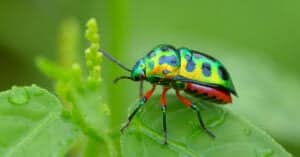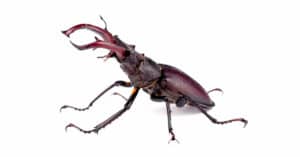As big as California is, it doesn’t quite have the number of beetle species that some of the other, much smaller states do. There are only about 125 different types throughout the state. As far as beetles native to California, the number is far fewer.
Some of these beetles are well known in the state, especially considering California’s enormous farmland. Most people think of Silicon Valley and Hollywood when they think of California. But most of the state is rural, and there are 77,100 farms and ranches as well.
Where there is farmland—crops, vegetables, fruit trees, animals, and flowers—beetles are a certainty. They make up 40% of all the insects in the world, after all. The Japanese beetle is the most feared insect when it comes to California farmers, but they aren’t the only beetles in Cali, and most of them are genuinely fascinating and harmless.

The
Japanese beetle
is the most feared insect when it comes to California farmers.
©iStock.com/mirceax
Flying Beetles in California
Most beetles fly, but most of them aren’t very good at it. Their flight capabilities are slow, sluggish, and occasionally meandering. Most beetles have two sets of wings. The outer wings, which are generally the most colorful and unique, rest on top of the inner wings.
The outer wings serve as a protective shell for the far more vulnerable inner wings, the latter of which is responsible for most of the beetle’s propulsion. One of the most infamous flying beetles in California is the fig beetle. These are pretty beetles and are often known as figeater beetles. That’s where the nice stuff ends.
They’re like bulldozers in the air, inch-long, flying insects that smack into anything in their path, whether it’s a porch light or your face. Though their emerald bodies are pretty to look at, it’s hard to observe when running around, swatting at the air to make this bombardier beetle go away.
Cigarette beetles, June beetles, rice weevils, and a variety of longhorn beetles are fliers as well. However, since they tend not to fly into people and objects, they are lesser known and recognized by most Californians.
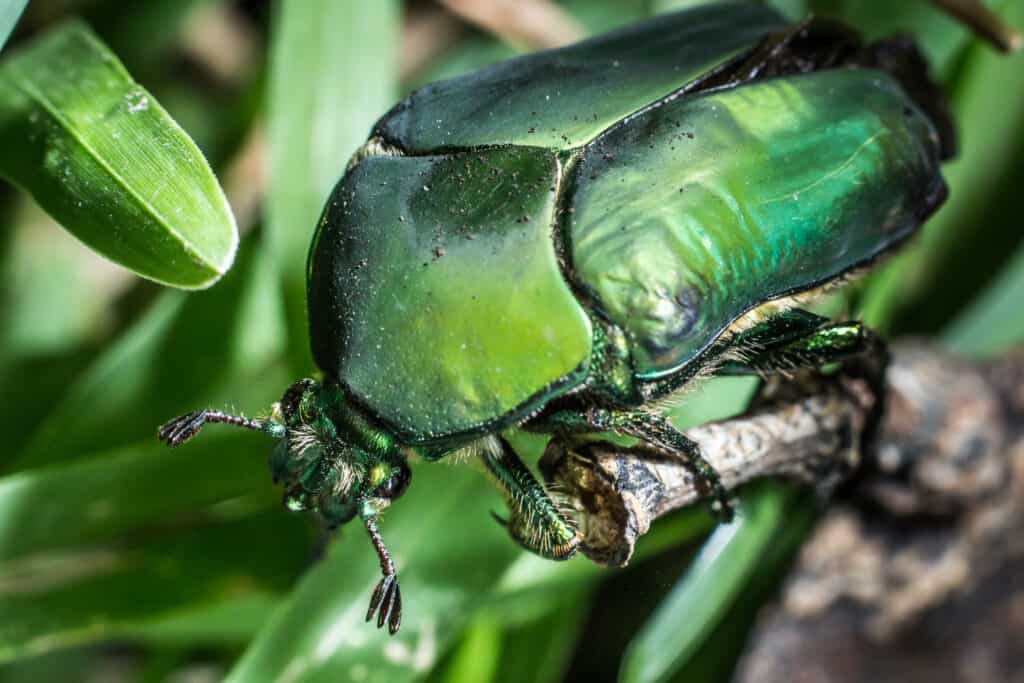
Figeater beetles have the classic scarab beetle appearance. They’re stout-bodied with hard elytra covering their thorax and abdomen.
©Auribe/Shutterstock.com
Large Beetles in California
Honestly, there are some beetles out there that belong in a Hollywood horror movie, and most of them are massive. These types of beetles make huge, vibrating flight sounds (like a hummingbird) that strike fear in everything around them. Some of them also sport massive pincers that look like they could take down an adult bull.
Fortunately, for the human race as a whole, these beetles are often pretty docile and harmless. The California Prionus Beetle can reach 4″ in length, which is a mind-boggling size for an insect. They are known for their appetite for certain trees, which qualifies them as a pest.
The Ponderous Borer Beetle, also known as the Western Pine Sawyer, can reach up to 3″ in length. They prefer to go after dead conifers and pines, boring down inside them to lay their eggs.

The
California Prionus Beetle
can reach 4″ in length, which is a mind-boggling size for an insect.
©mikeledray/Shutterstock.com
Brown Beetles in California
One of the most well-known California beetles is the darkling beetle, which belongs to the family of brown beetles. These specific darkling beetles are pretty dark, almost black in appearance. The cigarette beetle, June beetle, rice weevil, and longhorn beetles listed above are also brown beetles.
California is also home to leaf beetles, click beetles, water-scavenger beetles, rove beetles, and pinching bugs, all of which belong to the brown beetle family. Brown beetles are fairly common, which is to say, fairly common amongst the most common insects in the world.
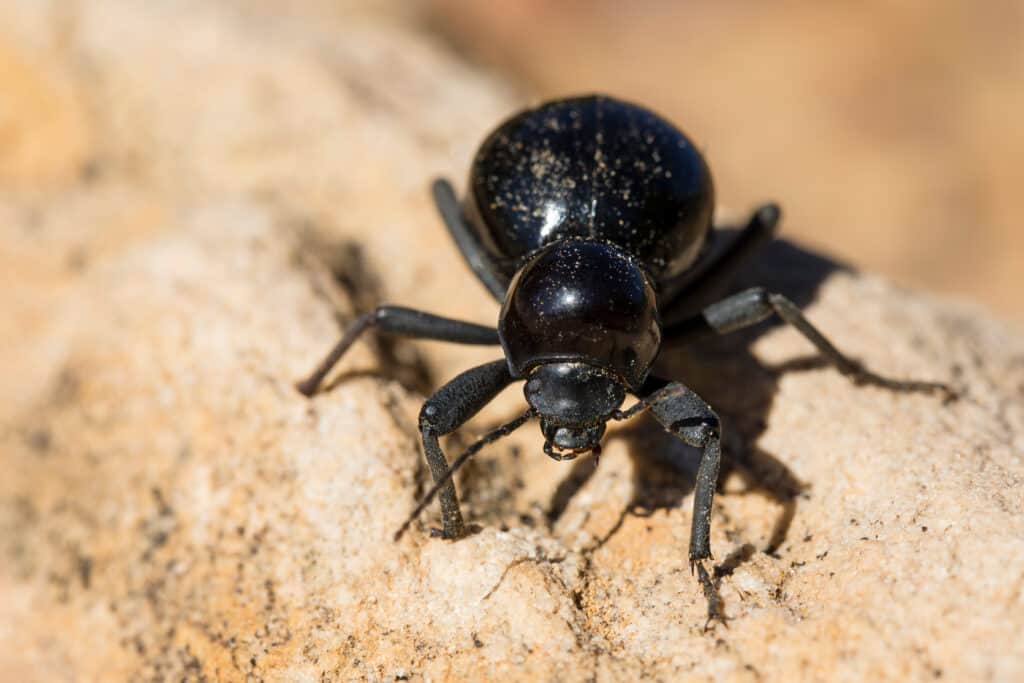
Darkling Beetles are burrowers and typically like to be near or even inside their primary food source.
©Therina Groenwald/Shutterstock.com
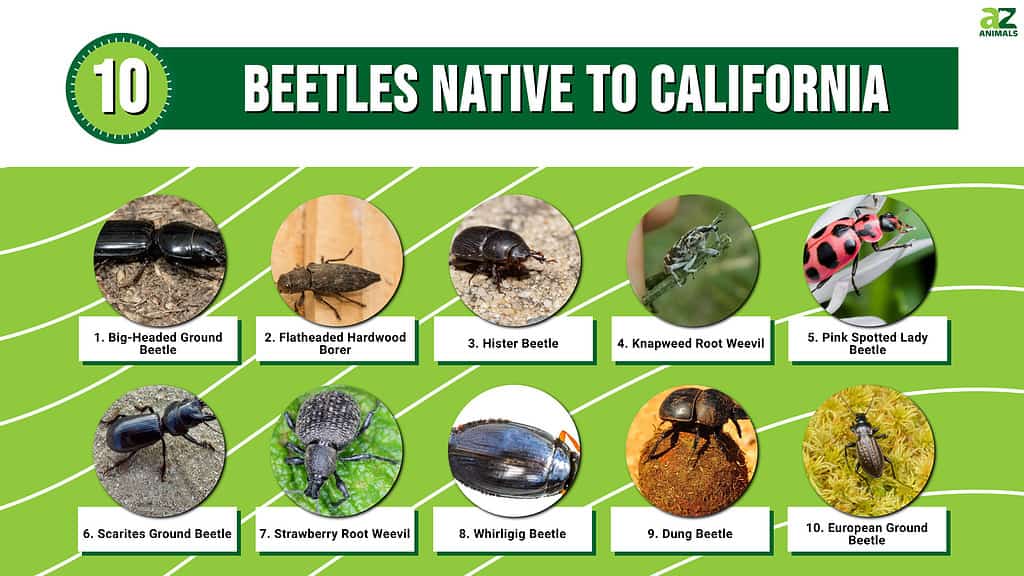
1. Big-Headed Ground Beetle
Big-headed ground beetles have an intimidating look to them but they are really neutral and occasionally beneficial. These beetles are voraciously hungry predators, grow fairly large, and are just as ferocious in their larvae stage as they are in their adult stage.
What makes them beneficial is their garden expeditions. When one of these beetles wanders into your garden, don’t get rid of it. They’ll wreak havoc on every type of pestilential bug you can imagine, consuming them all and looking for more. The big-headed ground beetle will help clear your garden of dangerous insects, which makes it a keeper.
Of all the beetles native to California, this one is the one you want on your property. They’re usually black or dark brown in appearance and feature a series of vertical lines along their abdomen. Their thorax is large but not quite as big as their abdomens, and their heads feature a nasty little row of pincers and feeding protrusions.
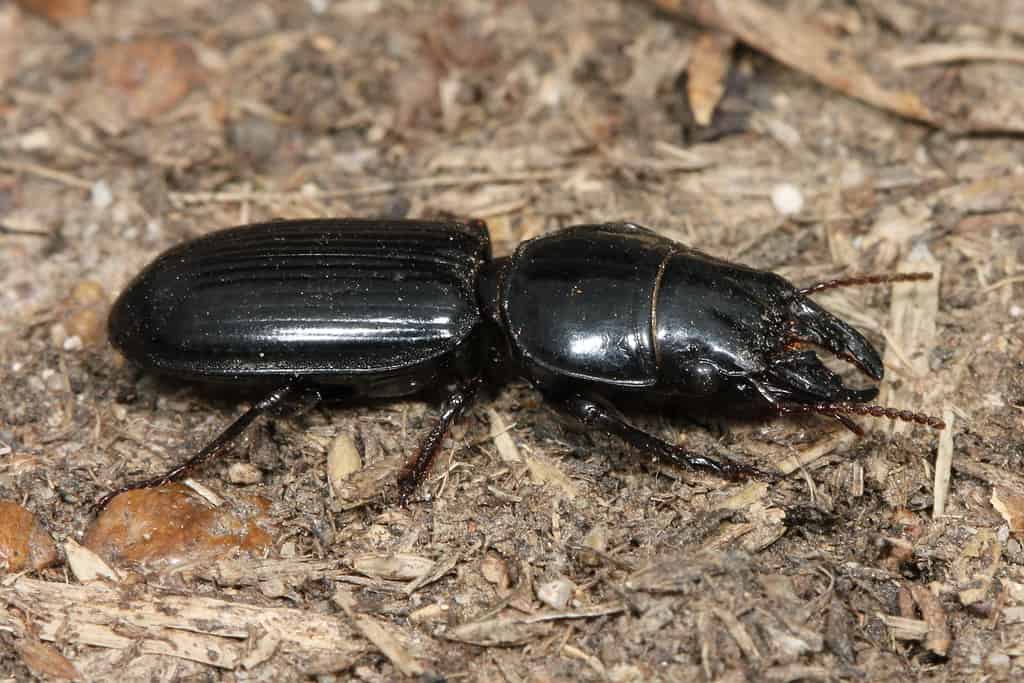
Big-headed ground beetles have an intimidating look to them but they are really neutral and occasionally beneficial.
©3,000 × 2,000 pixels, file size: 2.09 MB, MIME type: image/jpeg – License
2. Flatheaded Hardwood Borer
As its name implies, the flathead hardwood borer prefers to hang out on and inside hardwood trees, burrowing down into the wood to lay its eggs. They’re large beetles with a mottled gray and black appearance and short, hair-like antennae.
Flathead hardwood borers fly into action when spring rolls around, digging into the outer layers, just beneath the bark of their hardwood tree of choice. They lay their eggs just below the bark layer, and the emerging larvae tunnel farther into the tree than the adult.
Of course, this has a detrimental effect on the tree, especially when it’s done en masse. While flatheads avoid living conifers, they are quick to take advantage of recently felled trees, which has an impact on the lumber industry if the trees aren’t processed quickly.

Flathead hardwood borers fly into action when spring rolls around, digging into the outer layers, just beneath the bark of their hardwood tree of choice.
©Jay Ondreicka/Shutterstock.com
3. Hister Beetle
The hister beetle has a huge, square body with rounded corners and lines that seemingly divide it up into quarters. The term “huge” is used to describe the body about the head, with the actual size of the beetle being fairly small, around .3″.
For some reason, histers are the only beetles native to California that spend the vast majority of their time with ants and termites. The different insects get along just fine it would seem. Hister beetles prefer to dig up underneath outer layers of bark, where they make their homes and lay eggs.
For the most part, their diets consist of decaying organic matter, mostly the rotten, decaying portions of trees and various plants.
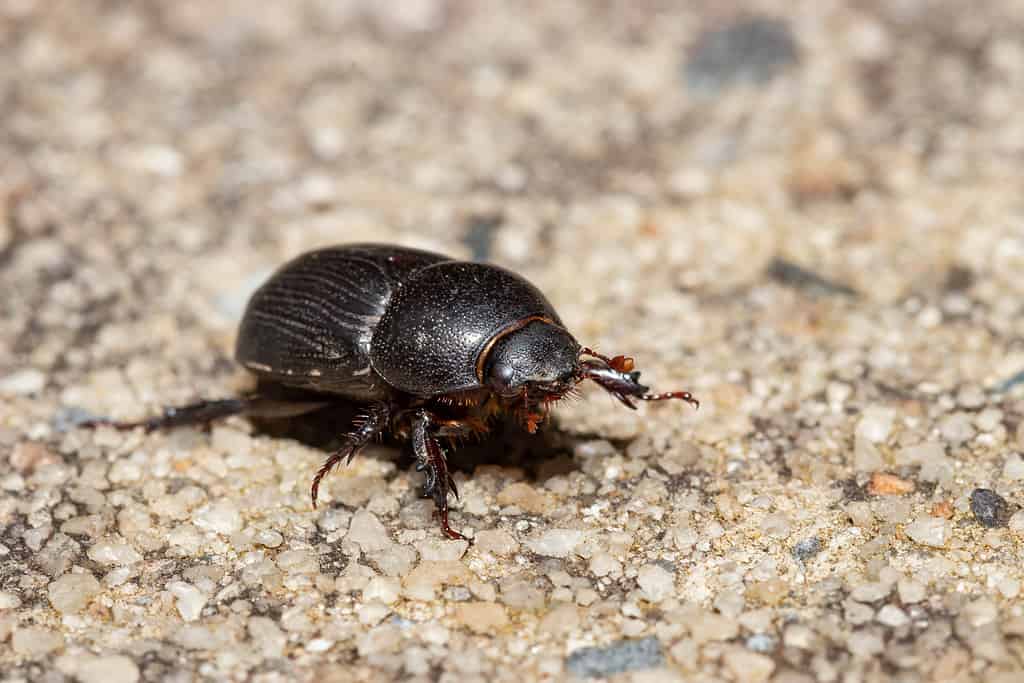
©Nick Valego/Shutterstock.com
4. Knapweed Root Weevil
The knapweed root weevil is an interesting-looking beetle, with a snout reminiscent of an anteater. The antennae are located on the pointed end of the snout, seemingly distant from the actual head, though the snout is a part of the head.
The largest of the knapweed only grow to about 3/4 of an inch, and they are a camouflaged grey and tan combination, with tiny, black spots across the surface of their wings. If you look closely enough, the surface of the knapweed root weevil looks like it is covered in a fine layer of fur.
This is especially true with the legs, which feature large segmentations and have a wooly mammoth-like appearance. They are considered to be pests, since they feed on the roots of various plants and trees indiscriminately, which allows fungi and other bacteria to intrude, ultimately killing the tree.
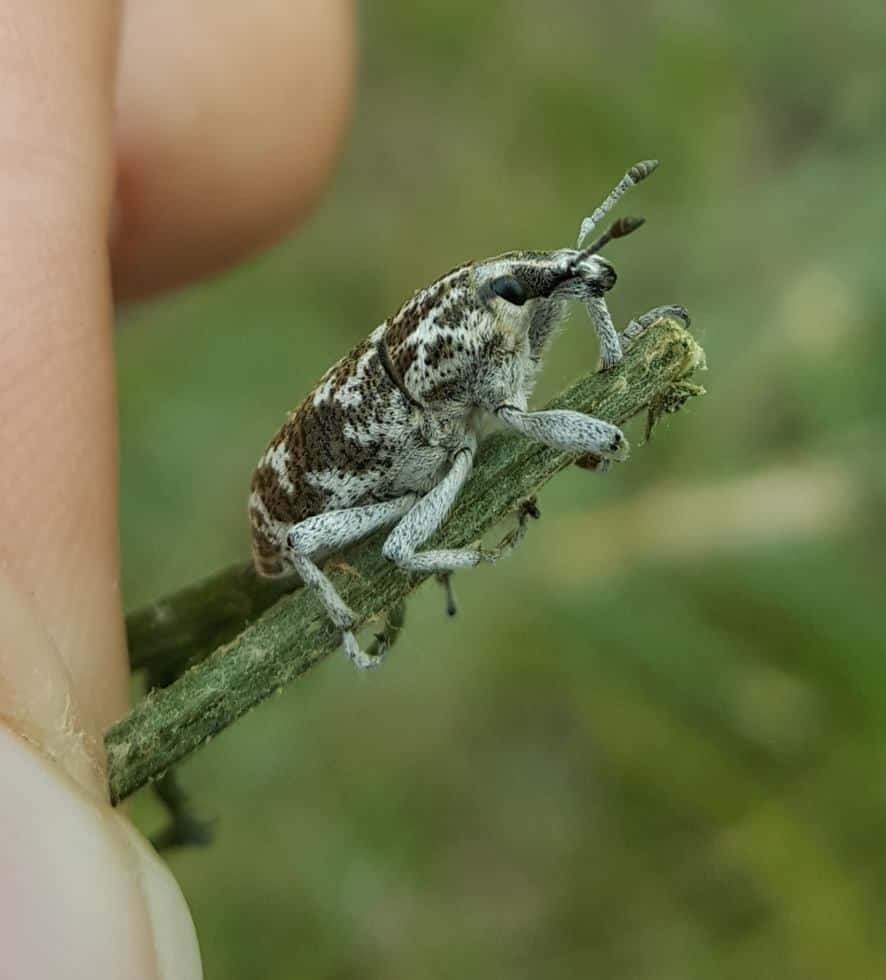
The knapweed root weevil is an interesting-looking beetle, with a snout reminiscent of an anteater.
©886 × 980 pixels, file size: 68 KB, MIME type: image/jpeg – License
5. Pink Spotted Lady Beetle
The pink-spotted ladybeetle belongs to the large family of ladybugs and resembles the seven-spotted ladybug in many ways. The most glaring difference is the huge black spots, which are usually much smaller on other ladybug types.
The familiar red backdrop is still there, though it has more of a pinkish hue to it than others. Starting from the abdomen and moving to the thorax and head, the entire body is very symmetrical in appearance, with each part an equal size smaller than the one before it. The thorax has two large dots, as does the head, which looks very unique when taken with the whole.
The pink-spotted ladybug feeds on aphids, so its presence is a boon to gardeners.
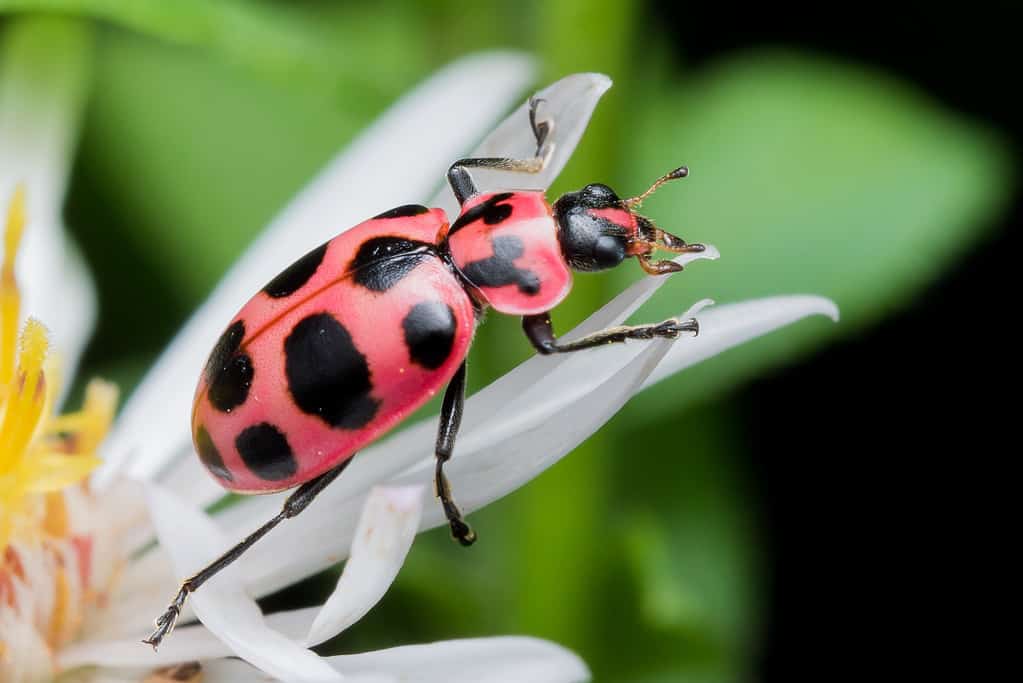
The pink-spotted ladybeetle belongs to the large family of ladybugs and resembles the seven-spotted ladybug in many ways.
©Steven Ellingson/Shutterstock.com
6. Scarites Ground Beetle
The scarites ground beetle is a big fan of caterpillars when it comes to eating them that is. They have the appearance of a single segmentation, between the abdomen and thorax. However, they have heads, though it looks like the head runs into the thorax seamlessly.
They’re a glossy black, dark brown color, with very small pincers on their front that overlap when closed, rather than snapping directly together. They share a similar look with traditional stag beetles, albeit with smaller pincers and smaller bodies.
The largest of the scarites will reach a shade over an inch, with the smallest around a third of an inch.

They’re a glossy black, dark brown color, with very small pincers on their front that overlap when closed, rather than snapping directly together.
©Dmitry Fch/Shutterstock.com
7. Strawberry Root Weevil
Some beetles are named after certain fruits, vegetables, or trees because they resemble those comparisons. Some are named that way because it makes up their primary diet. The strawberry root weevil is a bit of both.
Not only does it resemble a much darker strawberry, with a similar surface look and texture, but they enjoy digging down into the earth and feeding on the roots of strawberry plants. They’re very small beetles, only measuring about .2″ fully grown, but they can cause a lot of damage for their size.
They don’t just go after strawberries either. Strawberry root weevils target raspberries, peppermint, grapes, and rhododendrons.
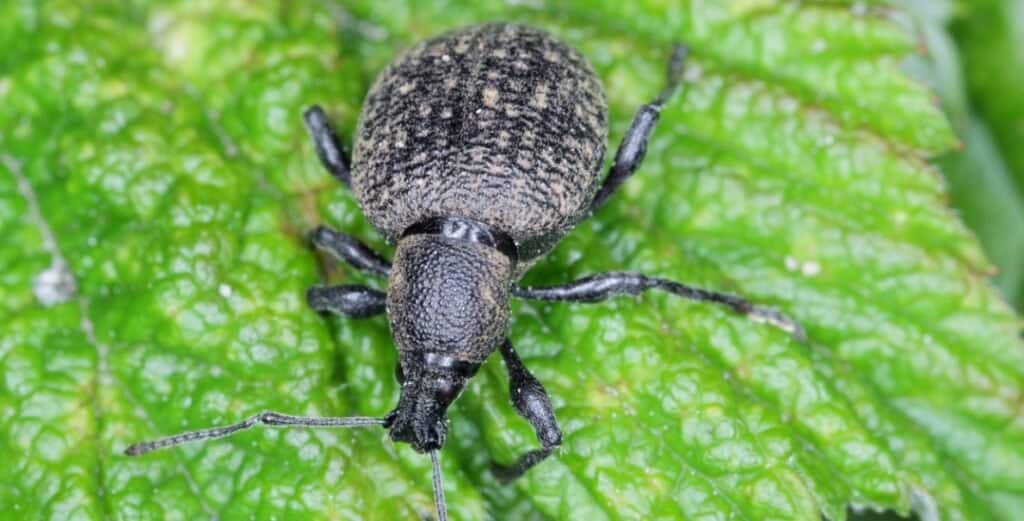
Strawberry root weevils target raspberries, peppermint, grapes, and rhododendrons.
©iStock.com/Tomasz Klejdysz
8. Whirligig Beetle
The whirligig beetle is a very oval, slick, and glossy-looking insect. It only grows to about a third of an inch, but it’s a very polished beetle all the same. The Whirligig beetle is one of the more unique beetles native to California. They spend most of their lives on or in the water, almost as if they are amphibious in breathing mechanics and preference.
They’ve also been around since the late Jurassic period. It’s hard to spot a whirligig if it doesn’t want to be found. They submerge when they feel threatened, and their often dark colorations blend in with the dark waters, submerged trees or roots, and vegetation.
They also have extremely short antennae. So short that they merely look like an aesthetic marker on the forward sides of the head.

The whirligig beetle (Gyrinus natator) is a type of water beetle that is named for swimming in circles when threatened.
©Maximillian cabinet/Shutterstock.com
9. Dung Beetle
The dung beetle is probably one of the more distasteful beetles, considering its daily occupation. Plus, this beetle just doesn’t have much going for it in terms of aesthetics. Dung beetles are usually dull, dark brown, or black, squarish in shape, with rounded corners.
Like many common beetles, they feature a tight series of lines running vertically down the thorax and abdomen parts of their bodies. They have small heads that barely remain proportional to the rest of the body and tiny, somewhat stubby legs.
The largest of them will reach a shade over an inch, while the smallest will never exceed a third of an inch. As their name implies, dung beetles feed on animal feces. They also lay their eggs in it so their hatching young ones can also partake in the festivities.

The dung beetle
is probably one of the more distasteful beetles, considering its daily occupation.
©Michael Potter11/Shutterstock.com
10. European Ground Beetle
The European ground beetle is mostly black, but there’s a sheen to it, much like catching an oil slick in the water when the sun hits it just right. It’s a semi-flat beetle that grows to a length just short of an inch. The head resembles a plate that slightly overlaps the thorax, and the thorax slightly overlaps the abdomen.
The diet of the European ground beetle is an interesting one. They like to eat slugs. As such, these ground beetles are often found hanging out near water, and damp or saturated undergrowth. In other words, places where slugs are most likely living.
The European ground beetle is sort of sizeable and completely harmless. Since they have a similar body shape to that of roaches, people often avoid them, though they aren’t known for carrying any significant diseases.
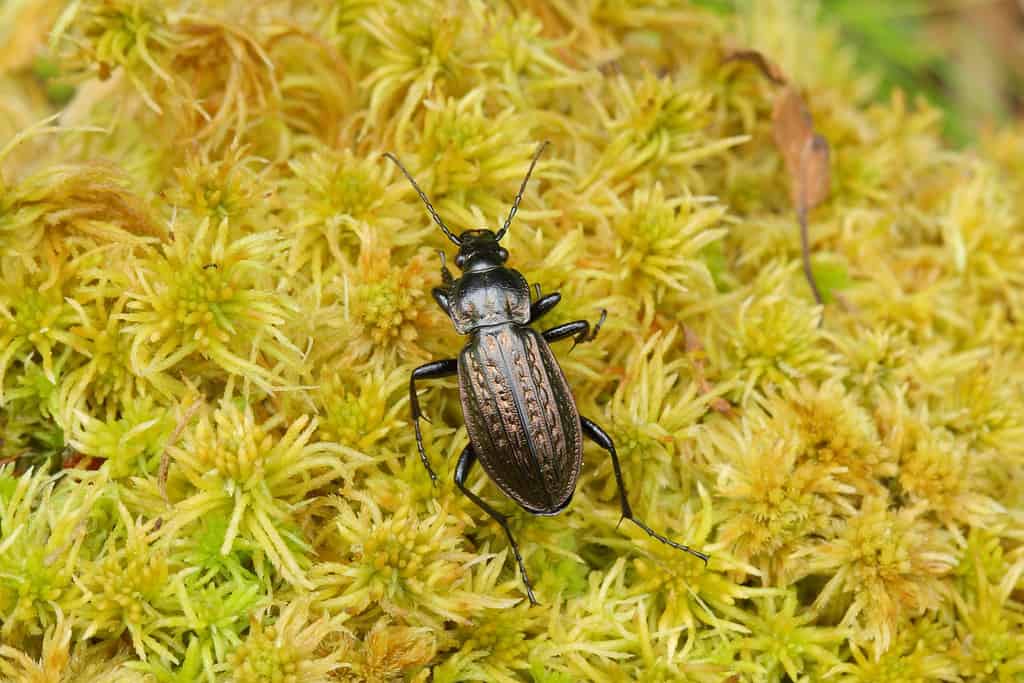
The European ground beetle is sort of sizeable and completely harmless.
©Peter Muckstein/Shutterstock.com
Final Thoughts
There you have it, ten beetles native to California, along with some brown, flying, and large beetles to boot. Though California is the third largest state in the US, it has comparatively fewer beetle species than other states, some of which are much smaller.
Despite that, there are still a ton of beetles in California. Since there are more beetles in this world than any other living species, it’s hard to find a place where beetles aren’t prevalent. California is a beautiful state, and if you’re a beetle aficionado, you’ll find some interesting species there as well.
Summary of Ten Beetles Native to California
| Rank | Native Californian Beetle |
|---|---|
| 1 | Big-Headed Ground Beetle |
| 2 | Flatheaded Hardwood Borer |
| 3 | Hister Beetle |
| 4 | Knapweed Root Weevil |
| 5 | Pink Spotted Lady Beetle |
| 6 | Scarites Ground Beetle |
| 7 | Strawberry Root Weevil |
| 8 | Whirligig Beetle |
| 9 | Dung Beetle |
| 10 | European Ground Beetle |
The photo featured at the top of this post is © Steven Ellingson/Shutterstock.com
Thank you for reading! Have some feedback for us? Contact the AZ Animals editorial team.



